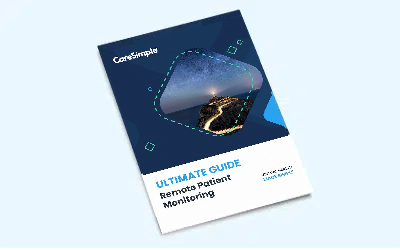When it comes to implementing a successful remote patient monitoring (RPM) program, there are many important factors to consider, like offering simple, cellular connectivity in devices and an emphasis on interoperability, to name just a few. Ultimately, though, the most essential element may be scalability, or the ability for programs to grow with the organizations they serve. Here’s a closer look at why scalability matters in RPM program design, and how to choose a service provider that can deliver it.
Why scalability is key to RPM program success

Get a crash course in RPM with the CareSimple Ultimate Guide.
Remote patient monitoring programs also reduce the labor it takes to closely monitor a large number of patients on a remote basis, while helping to make sense of the resulting data. It also enables care teams to more easily collaborate one another and gives them ready access to specialists in other locations. All of this can contribute to better care, and promote job satisfaction at a time when retention is a challenge.
By seamlessly integrating with an organization’s EHR/EMR system, remote patient monitoring programs can also help put in place analytical capabilities to drive further savings via continuous improvement. Indeed, as this capability has evolved, RPM has also fueled interoperability among the different hospitals, clinics, skilled nursing facilities, long-term care communities, home health providers, insurers and everyone else that uses it, further boosting efficiency by simplifying communications, processes and workflows.
As considerable as these benefits are, though, some concerns remain among some organizations. One of the most frequent questions is whether an RPM solution can be trusted to grow in the future. After all, if the point of an RPM program is to meet an ever-expanding foundation of patient care needs in the years and decades to come, then a deciding factor in choosing a partner should be its ability to truly grow with the organizations it serves.
But that’s easier said than done. Economic fluctuations aren’t always predictable, making long-term projections difficult to map. Healthcare utilization can be especially volatile, as the world learned during the Covid-19 pandemic. So, making sure that a program can scale up or down requires resources and reliability on the behalf of the partner — and whether they’re truly up to the task can be hard to gauge at first glance. To that end, here are six factors to consider when assessing RPM program scalability.
6 steps to successful RPM program scalability
To some extent, scalability is built into RPM programs, which are designed to begin with smaller pilot groups and then ramp up to larger populations. In theory, once the basic infrastructure is in place, all that is needed is additional investments in medical devices — more accessible than ever — along with the assurance that the provider will still have the resources to meet your needs in the years to come.
In addition, RPM programs are by their nature adaptable, designed to bring care to more people — which is why it’s often cited as a way to promote health equity. As the HHS telehealth guide points out, the virtual visits aspect of remote patient monitoring can now be carried out by a wide variety of familiar applications like Apple FaceTime, Facebook Messenger, Zoom, Skype, WhatsApp and many others. Telephone calls often qualify for virtual visits, too.
Yet even so, healthcare operators shouldn’t assume that the RPM program scalability they truly need will be built in. It’s important to make sure that the capacity for future growth is addressed in any requests for proposals or information associated with the selection process. In addition, there are a few specific areas to look into to best understand the capacity of a program to scale with your organization.
#1: Program design
Understanding the philosophy of a provider’s RPM program design can help clarify whether it’s really flexible enough to meet your needs. Does it enroll and onboard patients that’s easy to manage and engage with? A program that’s designed to win the acceptance of as many patients as possible through easy-to-use devices and interfaces is a better bet for long-term scalability than one that isn’t.
#2: History, mission and philosophy
It’s a good idea to get to know a company’s leaders as well as its clinical implementation team. Do they really understand and embrace RPM because they’re passionate about and experienced in healthcare technology? Are they an established player with verified relationships in the industry? Or are they just another startup looking to capitalize on the surge in demand for telehealth solutions?
#3: Experience and proven outcomes
In addition to a reputation for quality and a deep bench of industry expertise, a well-established RPM vendor should also be able to offer proven data on outcomes. How many partners do they serve? Can they show evidence of success? It’s also important to request any testimonials and case studies that demonstrate success — not just in the short term, but over a period of time.
#4: Compatibility
Integration and interoperability are key to RPM program success today, and vendors should emphasize these elements. Look for a partner that offers seamless interoperability with as many EHR/EMR service providers as possible, and who makes a point of making its service compatible with patient apps and portals, user engagement tools, and other resources that are important to success and scalability.
#5: Ease of use
Remote patient monitoring devices have come a long way in the past decade alone. Previous reliance on Wi-Fi or Bluetooth® technology may have alienated some tech-averse patients. Today, though, many RPM devices offer cellular connectivity for a minimum of patient effort and frustration. This also helps address social disparities of health, which in turn will spread access to even more users.
#6: Attention to funding and program ROI
Another essential factor in RPM program scalability is a plan for future funding. Since initial funds often come in the form of temporary government grants, some leaders may wonder how to parlay that into a long-term program. So, make sure your RPM program partner understands how to build a program that truly addresses your operational needs in a way that becomes self-sustaining as quickly as possible.
Take a deeper dive into RPM funding opportunities
Ensure RPM program scalability with CareSimple
If you’re seeking an RPM program vendor that can ensure future scalability, you’ve come to the right place. As a leading provider of RPM solutions, we understand what it takes to achieve success in remote patient monitoring. Contact us today to learn more about how we can help your organization build an RPM program that best meets your specific patient care goals.
And if you’re looking for a deeper dive into RPM, we’ve got you covered with the CareSimple Ultimate Guide to Remote Patient Monitoring. You can download your free copy here.
